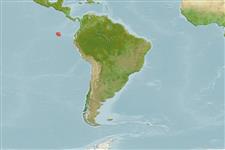Environment: milieu / climate zone / depth range / distribution range
Ecología
marino asociado a arrecife; rango de profundidad 1 - 12 m (Ref. 11482). Tropical
Distribución
Países | Áreas FAO | Ecosistemas | Ocurrencias, apariciones | Point map | Introducciones | Faunafri
Southeast Pacific: endemic to the Galapagos Islands.
Tamaño / Peso / Age
Maturity: Lm ? range ? - ? cm
Max length : 45.0 cm TL macho / no sexado; (Ref. 11482)
Short description
Morfología | Morfometría
Espinas dorsales (total): 13; Radios blandos dorsales (total): 15; Espinas anales 3; Radios blandos anales: 12. Bluish grey with blackish margin on gill cover; diagnostic white patch just in front of each eye (Ref. 11482).
Usually seen in aggregations while grazing over shallow reefs (Ref. 11482). May also mix with schools of other species (Ref. 5227).The fine mat of comb-like, bicuspid and tricuspid teeth are used to scrape algae from rocks and corals (Ref. 28023).
Life cycle and mating behavior
Madurez | Reproducción | Puesta | Huevos | Fecundidad | Larva
Allen, G.R. and D.R. Robertson, 1994. Fishes of the tropical eastern Pacific. University of Hawaii Press, Honolulu. 332 p. (Ref. 11482)
IUCN Red List Status (Ref. 130435)
Threat to humans
Harmless
Human uses
Más información
Nombres comunesSinónimosMetabolismoDespredadoresEcotoxicologíaReproducciónMadurezPuestaAgregación para la puestaFecundidadHuevosEgg development
Age/SizeCrecimientoLength-weightLength-lengthLength-frequenciesMorfometríaMorfologíaLarvaDinámica larvariaReclutamientoAbundanciaBRUVS
ReferenciasAcuiculturaPerfil de acuiculturaRazasGenéticaElectrophoresesheritabilidadEnfermedadesProcesamientoNutrientsMass conversion
ColaboradoresImágenesStamps, Coins Misc.SonidosCiguateraVelocidadTipo de nataciónSuperficie branquialOtolitosCerebrosVisión
Herramientas
Special reports
Download XML
Fuentes de Internet
Estimates based on models
Preferred temperature (Ref.
123201): 19.9 - 24.4, mean 23 °C (based on 47 cells).
Phylogenetic diversity index (Ref.
82804): PD
50 = 0.5000 [Uniqueness, from 0.5 = low to 2.0 = high].
Bayesian length-weight: a=0.01479 (0.00671 - 0.03258), b=3.08 (2.89 - 3.27), in cm total length, based on LWR estimates for this (Sub)family-body shape (Ref.
93245).
Nivel trófico (Ref.
69278): 2.0 ±0.00 se; based on food items.
Resiliencia (Ref.
120179): Medio, población duplicada en un tiempo mínimo de 1.4-4.4 años (Preliminary K or Fecundity.).
Fishing Vulnerability (Ref.
59153): Low to moderate vulnerability (35 of 100).
Nutrients (Ref.
124155): Calcium = 49.3 [23.9, 88.7] mg/100g; Iron = 0.587 [0.349, 1.000] mg/100g; Protein = 18.2 [16.9, 19.5] %; Omega3 = 0.0752 [, ] g/100g; Selenium = 29.1 [15.0, 60.9] μg/100g; VitaminA = 40.2 [9.0, 162.8] μg/100g; Zinc = 1.41 [0.95, 2.12] mg/100g (wet weight);
